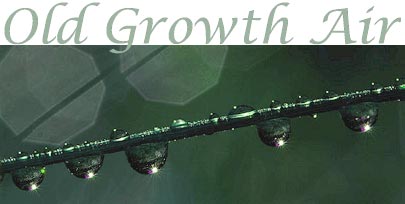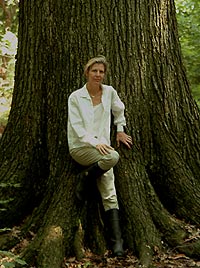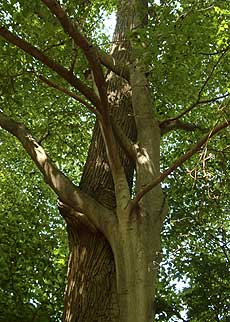|


by Joan
Maloof
Earth, my dearest, I will. Oh believe me, no
more
of your springtimes are needed to win me over —,
one,
ah, a single one, is already too much for my
blood.
—
Rainer Maria Rilke, "The Ninth
Elegy"
For years I have been telling my students that
our area has no old growth left whatsoever, that this land the
early explorers called Arcadia
because of its numerous, stately, trees has been completely
altered and not a single original forest remains. Depending on
my mood the day we discuss this, I either note it with anger
or sadness. Recently, however, I heard rumors of the existence
of a twenty-acre remnant of old growth forest. In my thinking,
twenty acres can barely be called a forest, but still I was
anxious to see this scrap. So yesterday when I woke to a true blue dream of a sky I knew right
away that this was a day I should visit—as in the e.e.
cummings poem, “i thank you god for this amazing
day,”—the leaping greenly spirit of
trees.
The forest was more than sixty miles away, and
detailed directions were necessary to find it down a dirt
road. Even before the car stopped I could smell that
smell—that sweet, rich, earthy smell—what I used to think was
the smell of the mountains. But here I was still on the
Delmarva Peninsula, on the flat land, and I was smelling the
mountains. Could it be that my ground used to smell like this
too—before the grandfather trees were gone? In a time when the
tree's breath merged with the breath of the fungi and the
birds and the insects?

Author Joan Maloof in an old
growth forest.
Photo by Rick
Maloof. |
When we discuss what we miss about forests after
they have been cut, it is usually the sight, or the shade, or
the species, that we mention; but now I am breathing deeply of
a forest gift that I had forgotten: the air! Americans have
largely ignored this dimension of the forest's allure, but the
Japanese recognize it and have a name for it: shinrin-yoku, wood-air bathing.
Japanese researchers have discovered that when diabetic
patients walk through the forest, their blood sugar drops to
healthier levels. The Japanese have hosted whole symposiums on
the benefits of wood-air bathing and walking. I have certainly
noticed that I feel better after a walk in the woods; I just
didn't know there was a name for my therapy.
So what could be in the forest air that makes us
feel better? In a study done in the Sierra Nevadas of
California, researchers found 120 different chemical
compounds—but they could only identify seventy of them! We are
literally breathing things we don't understand; which also
means, of course, that when we lose these forests, we don't
know what we are losing.
Some of the compounds in the air are coming from
the bacteria and the fungi in the soil, but most of the
chemical compounds in the forest air are given off by the
trees. Trees release volatile organic compounds from little
pockets between their leaf cells. There are a number of
theories about why they release the compounds: possibly to
deter insects, or possibly they are just metabolic by-products
and this is how trees eliminate them (having no excretory
system). The scientific community is still undecided.
I like to think of the enticing fragrances given
off by the trees as a sort of mutualistic reward for humans.
If you love how something smells you may be less likely to
chop it down. Sort of a Botany of
Desire, where the trees are using one of the few wiles
they have that work on humans. And I suppose it is not
inconceivable that the trees may be altering our perception
with their chemicals. The plant's volatile molecules evaporate
into the air and come into contact with the sensory neurons in
our nasal passageways. The olfactory nerves send messages
directly to the limbic system in our brains. This is the
system that deals with all our instinctive emotions, including
sex, memory, and aggression. The limbic system can most
certainly affect our physical bodies, and all of this can
happen even without our perception of having 'smelled'
anything.

Old-growth buddies: two trees
intertwine among the forest's fresh air.
Photo by Rick
Maloof. |
Aromatherapy practitioners work with these
plant-produced volatile compounds. They call them essential
oils, and they depend on folk wisdom about the effects various
compounds will have on our limbic systems. There hasn't been
much scientific research done on determining just what effect
these oils have. Often I put lavender oil in my bath, because
I love the fragrance; aromatherapists tell me it is supposed
to be calming. I can't say for certain if it calms me or not.
But I know that someone, somewhere, is planting more lavender
because I like the way it smells.
The molecules from the trees don't just go up
your nose, however. They are also part of the air that goes
into your lungs, and, once in your lungs, some of the
molecules enter your bloodstream. So when you walk through the
forest inhaling that sweet air—the wood-air—the forest
actually becomes a part of your body.
The most abundant compounds given off by trees
are monoterpenes. There has been a great deal of research done
on dietary monoterpenes, and the good news is that they have
been shown to both prevent and cure cancer. Many chemotherapy
drugs contain monoterpenes. Lemon rinds, in particular, are
high in monoterpenes. I could find no research, however, on
the effects of inhaling monoterpenes.
Aromatherapists claim that the monoterpenes in
pine are anti-viral and antiseptic, good for asthma and
respiratory infections. But not surprisingly, there is no
medical research to back up their claim. Could inhaling the
monoterpenes also be a cancer cure, like ingesting them is? Is
shinrin-yoku a valid therapy?
And perhaps an even bigger question: Why hasn't the Western
medical community researched the physical effects of inhaling
the monoterpenes so abundant in the forest air? Might it be
because forest air cannot be patented, and consequently there
is no money to be made from it?
It is popular to decry the destruction of
tropical rainforests—citing the wonder drugs that may
eventually be found there. Meanwhile, closer to home, we may
have medicines of our own lurking right beneath our noses.
Perhaps someday, when your physician asks you to “take a deep
breath,” it will be the old-growth air that he or she is
referring to.
I hope you don’t have to drive too far to reach
it.
 Joan
Maloof teaches biology
and environmental studies at Salisbury University in Maryland.
She has an active interest in botany, especially native plant
identification. Her current research is centered on a rare
sub-alpine plant which grows in the Western U.S.: Corydalis caseana. She is
studying plant-animal interactions with an emphasis on the
role of bumblebee nectar robbers. She has work forthcoming in
the Terra Nova book Progress and
Evolution. Joan
Maloof teaches biology
and environmental studies at Salisbury University in Maryland.
She has an active interest in botany, especially native plant
identification. Her current research is centered on a rare
sub-alpine plant which grows in the Western U.S.: Corydalis caseana. She is
studying plant-animal interactions with an emphasis on the
role of bumblebee nectar robbers. She has work forthcoming in
the Terra Nova book Progress and
Evolution.

Next >
>
|

